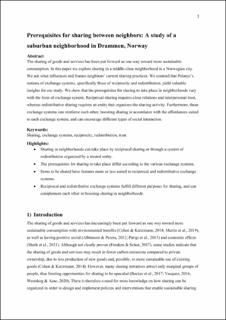| dc.contributor.author | Westskog, Hege | |
| dc.contributor.author | Aase, Tor Halfdan | |
| dc.contributor.author | Standal, Karina | |
| dc.contributor.author | Tellefsen, Sølvi | |
| dc.coverage.spatial | Norway | en_US |
| dc.date.accessioned | 2021-08-13T09:01:46Z | |
| dc.date.available | 2021-08-13T09:01:46Z | |
| dc.date.created | 2020-08-24T08:51:01Z | |
| dc.date.issued | 2020 | |
| dc.identifier.citation | Environmental Innovation and Societal Transitions. 2020, 37 39-49. | en_US |
| dc.identifier.issn | 2210-4224 | |
| dc.identifier.uri | https://hdl.handle.net/11250/2767733 | |
| dc.description.abstract | Sharing goods and services has been promoted as fostering more sustainable consumption. In this paper, we explore sharing in a middle-class neighbourhood in a Norwegian city. We ask what influences and frames neighbours’ current sharing practices, contending that Polanyi’s notions of exchange systems, specifically reciprocity and redistribution, yield valuable insights for our study. We show that reciprocal and redistributive sharing may reinforce each other by increasing the frequency of sharing and the variety of items shared. Furthermore, redistributive sharing systems may foster close relations and interpersonal trust, which are prerequisites for reciprocal sharing. Hence, if the goal is to increase the rate of sharing of goods and services in neighbourhoods like that studied here, two initiatives can be valid. First, items with the right affordances can be redistributed by existing institutions; second, reciprocity can be encouraged by organising more opportunities for resident interaction. | en_US |
| dc.language.iso | eng | en_US |
| dc.subject | Sharing | en_US |
| dc.subject | Exchange systems | en_US |
| dc.subject | ReciprocityRedistributionTrust | en_US |
| dc.subject | Reciprocity | en_US |
| dc.subject | Redistribution | en_US |
| dc.subject | Trust | en_US |
| dc.title | Sharing among neighbours in a Norwegian suburb | en_US |
| dc.type | Journal article | en_US |
| dc.type | Peer reviewed | en_US |
| dc.description.version | submittedVersion | en_US |
| dc.source.pagenumber | 39-49 | en_US |
| dc.source.volume | 37 | en_US |
| dc.source.journal | Environmental Innovation and Societal Transitions | en_US |
| dc.identifier.doi | 10.1016/j.eist.2020.07.010 | |
| dc.identifier.cristin | 1824695 | |
| dc.relation.project | Norges forskningsråd: 267442 | en_US |
| dc.relation.project | Norges forskningsråd: 295704 | en_US |
| cristin.ispublished | true | |
| cristin.fulltext | preprint | |
| cristin.qualitycode | 1 | |
